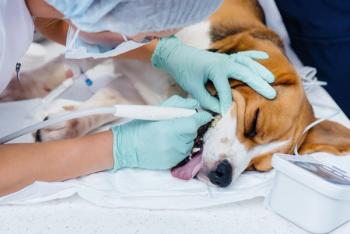
Preventable anesthetic mistakes and how to avoid them

Human error is inevitable, but it does not have to define how you operate. Implementing a surgical checklist can greatly reduce the number of errors associated with anesthesia and surgery.
This content is sponsored by Jurox.
At the Fetch dvm360® Conference in San Diego, held December 2-4, 2022, Darci Palmer, LVT, VTS (anesthesia & analgesia), presented on common anesthesia-related errors and what steps to take to avoid and minimize them. Although data relating veterinarian mortality to medical errors is limited, medical errors are likely responsible for a high number of veterinary-related deaths.1
Medical errors
An error is failing to complete a planned action as intended or using a wrong plan to achieve a goal. Further, it is a preventable adverse event, which is an event that occurs because of medical care or treatment, not an underlying disease or condition.
Medical errors can range from diagnostic and treatment errors to monitoring or preventative errors, failure of communication, equipment failure, and system failure. According to the Institute of Medicine, there are 2 types of cognitive tasks that could result in a medical error:
Everyday tasks. These are routine tasks such as setting up an anesthesia machine, setting out supplies for catheters, intubation supplies, etc. But so many factors can disrupt routine tasks—fatigue, interruptions, if you’re having a bad day—and end up causing an error.
Complex tasks. These tasks require conscious attention to detail, such as formulating an anesthetic drug plan, administering drugs, and calculating drug amounts. These types of tasks require a distraction-free environment.
Research shows that the major cause of errors is not due to a lack of good intention or negligence, but rather a breakdown in processes—either the process led personnel to make a mistake. or the process failed to help prevent the error.
Prevention
There are four categories of common anesthesia-related errors: equipment errors, math errors, airway/incubation errors, and drug errors.
To improve patient safety several steps can be taken. The first is to know you’re human and you’re going to make mistakes.
“We have to be OK with the fact that humans are not perfect,” Palmer said. “We are all going to make mistakes. It does not matter how many years you've been in practice or what your credential status is. I have seen errors be made by veterinary assistants, credentialed veterinary technicians, board specialists—it happens.”
It is important to be accountable and communicate your mistake and viewed as a learning experience. Many hospitals conduct morbidity-mortality rounds (M&M rounds) to review cases that failed. They focus on what went wrong, how it happened, and ways to prevent it in the future, but these rounds are not a means to criticize or punish the individual.
The second step is to create checklists. Checklists greatly reduce medical errors. Palmer cited a 2014 veterinarian study that showed a 75% reduction in anesthesia-related errors after two changes involving the use of checklists were implemented.
The third is to update your checklists. As Palmer said: “Remember, a [checklist] is a living document; it needs to be looked at on a continuous basis. Every month during your staff meeting, take a look at the checklist and ask, ‘Are there things we could remove? Are there things we could add?’ It has to be revisited on a regular basis.”
The fourth is to offer regular training opportunities. Whether a new instrument or piece of equipment is purchased or a new drug is introduced, training should be the immediate next step to ensure employees are well-versed and prepared. Weekly or monthly training sessions should also be implemented to improve employees’ knowledge of procedures, teach them new skills, and/or offer an opportunity to update processes and procedures.
Reference
- Palmer D. To err is human: preventable anesthetic mistakes. Presented at: Fetch dvm360® Conference; San Diego, California. December 2-4, 2022.
Newsletter
From exam room tips to practice management insights, get trusted veterinary news delivered straight to your inbox—subscribe to dvm360.




